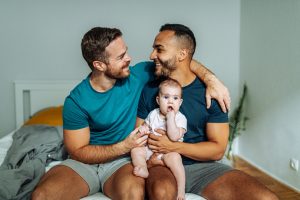The family-building landscape for lesbian, gay, bisexual, trans, and queer (LGBTQ) people has changed a great deal over the past several decades. My new book, LGBTQ Family Building: A Guide for Prospective Parents, covers a variety of pathways to parenthood, as well as guidance about how to navigate and circumvent various challenges that may arise along the way. I also share stories and statistics from “The LGBTQ Family Building Project,” my study of over 500 LGBTQ parents who built their families in various ways.
LGBTQ people report a number of barriers to pursuing parenthood. In the LGBTQ Family Building Project, for example, stigma and support related barriers included worries about teasing/harm for children (endorsed by 35% of parents), worries about discrimination in the family building process (30%), lack of LGBTQ role models (25%) and support from family 22%). Structural/practical barriers included financial considerations (58%) and geographic considerations (e.g., living in an LGBTQ unfriendly area) (18%). Personal circumstances also played a role (e.g., health concerns, 19%; partner who is uninterested in parenthood, 10%).
Ultimately, all of these individuals did become parents, the majority through adoption or reproductive technologies (e.g., donor insemination). Adoption may be particularly appealing to cisgender male couples, who have fewer affordable options when it comes to family building, as surrogacy is quite expensive (over $100,000). LGBTQ people may be drawn to adoption as a means of building their families because it is appealing from an altruistic perspective, affordable (if via the child welfare system, as opposed to private domestic adoption), does not introduce genetic or gestational inequities in parents’ relationship to their child (as is often the case in parenthood pathways involving reproductive technologies), or because other methods (e.g., donor insemination) failed. For LGBTQ folks who choose donor insemination or surrogacy, this is often desirable because partner has a strong desire to carry, give birth to, chestfeed (i.e., nurse), and/or be genetically related to a child. They also cite various deterrents to pursuing adoption, such as perceived costliness, the unpredictability and uncertainty associated with both the adoption process and child outcomes (e.g., emotional, behavioral, and health issues), as well as legal barriers and adoption agency stigma.
There are many ways that LGBTQ people can self-advocate for themselves in the process of building their families. They can evaluate adoption agencies, medical providers, sperm banks, and other family-building resources for their LGBTQ-competence and inclusion. For example, they can examine websites and other public-facing materials for the presence of inclusive language and images (e.g., photos of same-gender couples and people with diverse gender presentations) and apparent knowledge of the unique issues present for LGBTQ folks. They can speak to staff members, and ask them directly about whether and how their policies, staff training, staff, and clientele reflect and include LGBTQ people. Further, they can ask staff directly for referrals of prior LGBTQ clients as well as inquire about the presence of LGBTQ specific resources (e.g., legal resources; support groups).
Ultimately, LGBTQ people benefit when they share knowledge and resources with each other. In turn, LGBTQ people who have successfully navigated the family building process will ideally share this knowledge informally through community and friendship networks.
Abbie E. Goldberg is a Professor in the Department of Psychology at Clark University in Worcester, Massachusetts, where she also currently serves as the Director of Women’s & Gender Studies, and is the current holder of the Jan and Larry Landry Endowed Chair (2020-2023). Follow them on Twitter @DrAbbieG


Comments